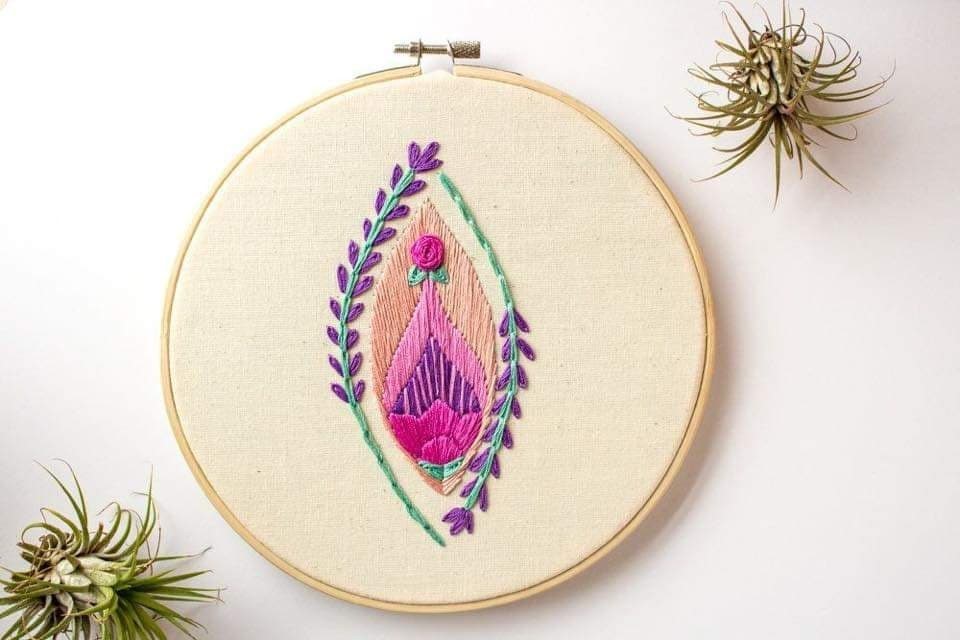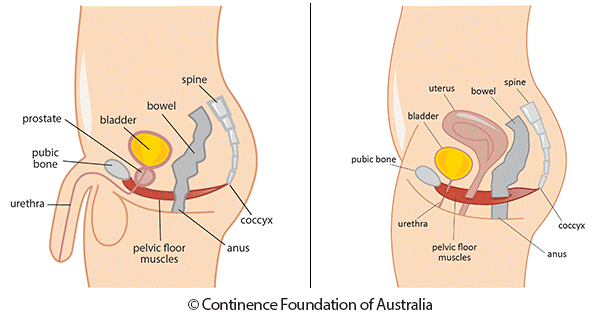
Let’s talk about Pelvic floor
We all heard this term but do we really know what it means?
Pelvic floor muscles are the layer of muscles that support the pelvic organs and span the bottom of the pelvis. The pelvic organs are the bladder and bowel in men, and bladder, bowel and uterus in women. The diagram below shows the pelvic organs and muscles in women (right) and men (left).

The muscles stretch like a hammock from the tailbone (coccyx) to the pubic bone (front to back) and from one sitting bone to the other sitting bone (side to side). These muscles are normally firm and thick.
Imagine the pelvic floor muscles as a round mini-trampoline made of firm muscle. Just like a trampoline, the pelvic floor is able to move down and up. The bladder, uterus (for women) and bowel lie on the muscle layer.
Having strong pelvic floor muscles gives us control over the bladder and bowel. Weakened muscles mean the internal organs are not fully supported and you may have difficulty controlling the release of urine, faeces (poo) or flatus (wind).
How can I find my pelvic floor muscles?
Method 1 – Stopping the flow
The first step in performing pelvic floor muscle exercises is to identify the correct muscles. There are several ways which may help you to correctly identify the different parts of your pelvic floor muscles. One way is to try to stop or slow the flow of urine midway through emptying the bladder. Stopping the flow of urine repeatedly on the toilet is not an exercise, but a way of identifying your muscles. This should only be done to identify which muscles are needed for bladder control.
If you can, stop the flow of urine over the toilet for a second or two, then relax and finish emptying without straining. This ‘stop-test’ may help you identify the muscles around the front passage which control the flow of urine. It is not recommended as a regular exercise.
Method 2 – Visualisation
Another method to identify your muscles is to imagine stopping the flow of urine and holding in flatus (wind) at the same time. This can be done lying down, sitting or standing with legs about shoulder width apart.
- Relax the muscles of your thighs, bottom and tummy.
- Squeeze in the muscles around the front passage as if trying to stop the flow of urine.
- Squeeze in the muscles around the vagina and suck upwards inside the pelvic.
- Squeeze in the muscles around the back passage as if trying to stop passing wind.
- The muscles around the front and back passages should squeeze up and inside the pelvis.
- Women who are familiar with using tampons can imagine squeezing in the vagina as if squeezing a tampon up higher in the vagina.
- Identify the muscles that contract when you do all these things together. Then relax and loosen them.
Why should I do pelvic floor muscle training?
Women of all ages need to have strong muscles. Pelvic floor muscles can be made weaker by:
- not keeping them active;
- pregnancy and having babies;
- constipation;
- being overweight;
- heavy lifting;
- coughing that goes on for a long time (such as smoker’s cough, bronchitis or asthma);
- growing older.
Women with stress incontinence – that is, women who wet themselves when they cough, sneeze or are active – will find pelvic floor muscle training can help in getting over this problem.
For pregnant women, pelvic floor muscle training will help the body cope with the growing weight of the baby. Healthy, fit muscles before the baby is born will mend more easily after the birth.
After the birth of your baby, you should begin muscle training as soon as you can. Always try to “brace” your pelvic floor muscles (squeeze up and hold) each time before you cough, sneeze or lift the baby. As women grow older, the pelvic floor muscles need to stay strong because hormone changes after menopause can affect bladder control. As well as this, the muscles change and may get weak. A pelvic floor muscle training plan can help to lessen the effects of menopause on pelvic support and bladder control.
Pelvic floor muscle training may also help women who have the urgent need to pass urine more often (called urge incontinence).
When to seek professional help
Seek professional help when you have bladder or bowel control problems with symptoms such as:
- needing to urgently or frequently go to the toilet to pass urine or bowel motions
- accidental leakage of urine, bowel motions or wind
- difficulty emptying your bladder or bowel
- vaginal heaviness or a bulge, or
- pain in the bladder, bowel or in your back near the pelvic floor area when exercising the pelvic floor or during intercourse.
Incontinence can have many causes and should be individually assessed before starting a muscle training program. Tightening or strengthening pelvic floor muscles may not be the most appropriate treatment so speak to a health professional if you have persistent problems with your bladder or bowel.

